Stained Glass Windows
History of the Stained Glass Church Windows
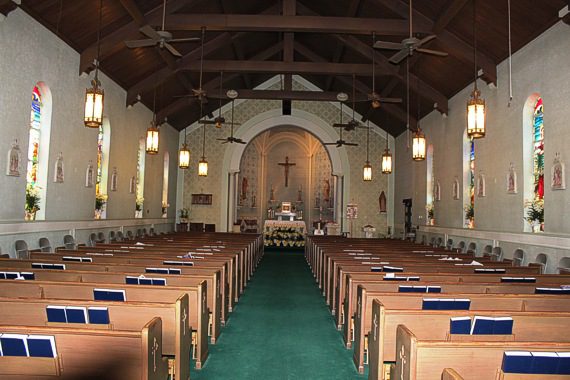
Stained glass
is a widely used art form that has been widely adopted to the decoration of church buildings or religiously oriented structures. Stained glass chiefly has become an expression of religion. Its best use is a perpetually decorative and silent proclamation of the story of God's love.
Stained glass is an art form itself. The good stained glass becomes a part of the architectural whole; as a window, it is a part of the wall. Stained glass windows originated in medieval times, in the twelfth and thirteenth centuries, and have become in many instances great art treasures.
(The windows of the Cathedral of Chartres and Mont St. Michele.) Ours were appraised in 1981 when we redecorated and renovated our church for over $100,000.00.
The color in stained glass is contained within the substance itself. Metallic ingredients such as gold, cobalt, chromium, and iron oxides are added to the glass while it is in a molten state. Some stains are painted on white glass to produce yellow tones, or pigment of a reddish-brown or black powdered oxide is added and made permanent by fusing with the surface of the glass at high temperatures.
When Matt Petersen made the sanctuary windows, he created the form of the window in metal, then he made metal dividers in which he placed large broken or oddly shaped pieces of the colored glass inside, then poured onto this a medium of some type, like cement or epoxy resin, and left it to harden for a time before removing the form. Matt then placed the finished product into the windows, which we have in the sanctuary today.
Today, the use of stained glass in the faceted pattern has been introduced. I think this is much like what is in the sanctuary. In this process, color is the main characteristic. Colored slab glass up to an inch or more in thickness is faceted by a process of shelling. This is done by striking the edge of the slab with a metal hammer. This causes the glass to break away, leaving facets where the shelled piece is broken loose, and these facets give a jewel-like quality and sparkle to the glass. The glass slabs, once faceted, are embedded in an epoxy resin, and while the epoxy appears cement-like, the faceted glass appears to be a decorative pattern of sparkling colors.
Antique methods of producing stained glass were of two kinds: (1) molten glass was poured onto a flat metal or stone surface, spread out thinly, and then cooled; (2) a fixed amount of molten glass was dropped on a flat surface and cooled into a flat circle with a raised center. Stained glass today comes in a variety of thicknesses and is made in sheets for the most part.
The art of stained glass is in the design, the use of color, the assembly of the colored pieces, and the fixing of them by strips of lead, and a final cementing and waterproofing. Some glass is stained and fired at a high temperature (1,200 degrees or more), and so the features or delineated lines of the design are made permanent.
Our church was built in 1939 under the direction and supervision of Father Edward N. Hinckley. The windows came slowly beginning in 1949. In those days, the cost was around $500 each, and that was a lot of money. Today, these same windows run over $5,000 apiece. As loved ones died and as Father Hinckley was able, little by little all the windows were put in place. Each was ordered one at the time and put in as they were donated.
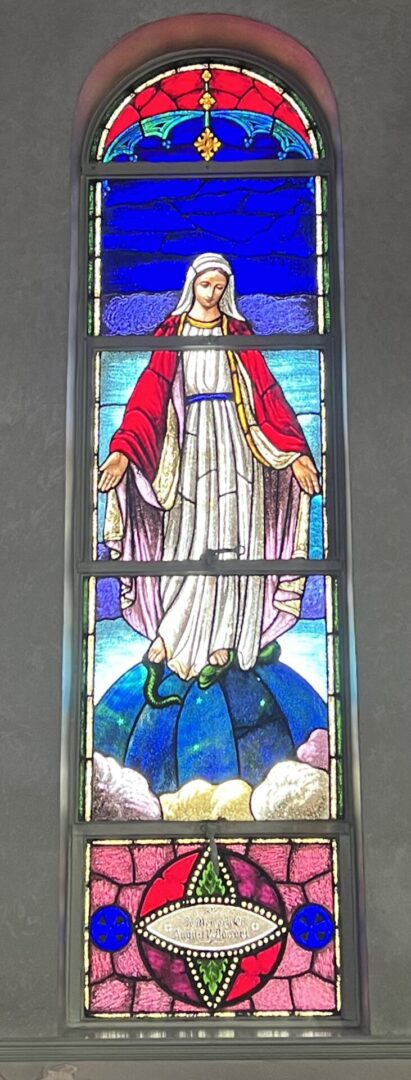
The Blessed Virgin Mary
After the accidental death of August V. (Goobie) Rocconi on January 26, 1949, his widow, Corinne Rocconi, had the first window installed in his memory later that year. She chose the Blessed Virgin Mary because August had such an intense devotion to the Mother of God, and she wanted something that would be a reminder of his love for her.
Mary is the patron of many countries. When she appeared at Guadalupe, she declared herself patroness of the Americas. In 1846, the Bishops of the US declared her patron of the United States. The Virgin Mary is honored under many titles. Our Lady of Guadalupe, The Madonna, The Immaculate Conception, the Immaculate Heart of Mary, Our Lady of Lourdes, Our Lady of Mount Carmel, Our Lady of the Most Holy Rosary, The Mother of Perpetual Help, and Maria Dolorosa (Our Lady of Sorrows) among a few.
There are several feasts honoring her that we celebrate; the Birth of Mary on Sept. 8, The Annunciation on March 25, the Visitation on May 31, the Purification of the Blessed Virgin Mary on February 2, Our Lady of Sorrows on September 15, Our Lady of the Rosary on Oct. 7, the Queenship of Mary on August 22, the Solemnity of Mary, Mother of God on January 1, and the Immaculate Heart of Mary on the Saturday following the second Sunday of Pentecost, under which title Pope Pius XII dedicated the whole human race to Mary in 1944.

Saint Joseph
The next window was a gift of the Borgognoni family, and this is St. Joseph. The Borgognonis chose St. Joseph because of Joe Borgognoni, Sr. and their devotion to St. Joseph.
Saint Joseph is the patron saint of carpenters, protector of the working people, and the patron of social justice of the universal church and the dying. He is a model for fathers of families, and Pope Leo XIII confirmed that his preeminent sanctity places him next to the Blessed Virgin Mary among the saints. His feasts are on March 19 and under the title of St. Joseph the Worker on May 1. He was the foster father of Jesus and the spouse of the Blessed Virgin Mary.
There is little in the Bible about him other than during the announcement and birth of Jesus and when Jesus was found in the Temple after being lost three days. Jesus was twelve at this time. We know that he was a carpenter and worked very hard to care for Mary and Jesus. They think that Joseph was probably dead by the time of the passion and death of Christ. The apocryphal "Photoevangelium of James" says he was an old man when he married Mary. We are told that he is the patron of the dying because he had Jesus and Mary at his bedside while he was dying.

Saint Lucy
Saint Lucy's window was a gift of the Sam Forte, Sr. family. Saint Lucy had special significance to the Forte family because Sam Forte's brother, Joe, had lost an eye at some point in his life. Saint Lucy is the patroness of diseases of the eyes.
Saint Lucy was born of noble parents at Syracuse, Sicily. She was sentenced to be burned to death when she refused marriage to a suitor who denounced her as a Christian. The flames made no impression on her. Finally, she was stabbed through the throat. They believe that she is the patron of those with eye troubles because of her name, which means “light.” One tradition has her eyes torn out by her judge, while another has her tearing them out to present to a suitor she disliked who admired them. In both cases, they were miraculously restored. Her feast day is December 13.

Saint Anthony of Padua
Saint Anthony of Padua's window was a gift of the Borgognoni family. Marcella Borgognoni had a great love for Saint Anthony and named two of her four sons after him, Joseph Anthony and Anthony Peter.
Saint Anthony is the patron of searchers for lost articles and barren women. Also of the poor and oppressed. (“St. Anthony's bread” is the name given for alms seeking his intercession.)
Saint Anthony was born in Lisbon, Portugal, Ferdinand de Bulhoes, the son of a knight at the court of King Alfonso II of Portugal. He studied under the priests of the Lisbon cathedral, joined the Canons Regular of St. Augustine at fifteen, and was ordained in 1219. He transferred to the Franciscans in 1221, taking the name Anthony. He became ill and was moved to a hospice where he delivered a sermon that launched his career as a preacher. He preached all over Italy and was noted for his eloquence, fire, and persuasiveness. He drew immense crowds and attacked corruption and wrongdoing and reformed many. He settled in Padua after 1226. He worked to abolish debtors' prisons, helped the poor, and worked ceaselessly and untiringly with heretics. In 1231, he died at the age of 36 from exhaustion and dropsy. He was undoubtedly one of the greatest preachers of all time. He is known as the “Wonder Worker” for the miracles he wrought.

Saint Therese the Little Flower
Saint Therese, the Little Flower, the window was a gift of the A and B Pieroni families. She was the patron saint of Theresa Pieroni, and Gigia Pieroni had special devotion to her. Out of their love for Saint Therese, they persuaded their husbands to donate a window in her honor.
Saint Therese is the patron of annoyances. In 1927, she was declared co-patron of the missions with St. Francis Xavier, and in 1944, was named co-patroness of France with Joan of Arc. Her feast day is October 1.
Saint Therese was born in Alencon, France, as Marie-Francoise Martin on January 2 in 1873, the youngest of nine children. She was raised by her sisters from the age of 5, when her mother died.
The family moved to Lisieux, and two of her sisters became Carmelites. She followed and professed there, in 1890, and took on the name, Therese of the Child Jesus. She was afflicted with tuberculosis and bore her illness with great patience.
It is said that when she would pray in church, a nun would clang her rosary against the bench, and she patiently endured this; thus, she was named the Patroness of Annoyances.
She wrote the story of her childhood and her life in the convent, “The Story of a Soul.” This was started in 1894 and completed in 1897. She died of tuberculosis at the age of 24 on September 24, 1897, and was canonized in 1925 by Pope Pius XI.

Saint Pope Pius X
Saint Pope Pius X window was given in memory of Santo J. Forte. Pope Pius X is known for lowering the age for children to receive Holy Communion. Santo Forte had two sons and two daughters. The two daughters were born with enlarged hearts, and it was thought they would not live to start school. However, they both lived into their 50s.
Virginia Marie worked in the library here for a number of years, and the two girls, after both parents died, took care of one another, and were exceptionally interested in everyone in the parish. They would send cards on various occasions to people, call, and ask about them and conveyed their concern and love for all in the village.
Pope Pius served as pope from August 4, 1903 to August 20, 1914. He was born on June 2 in 1835, the second of ten children of a cobbler and postman, Giuseppe Melchior Sarto near Trevino, Italy, was educated there, and entered the seminary at Padua in 1850. He was ordained there in 1858, did pastoral work for the next 17 years, and then was Diocesan Chancellor from 1875-84 at Treviso. He was appointed bishop of Mantua in 1884 where he served for nine years. He was then named cardinal and patriarch of Venice and elected Pope on August 4, 1903.
Pope Pius X began a codification of canon law, set up a commission to revise the Vulgate, reorganized the papal court, and ordered a revision of the psalter and the breviary. He was responsible for many other good causes, such as his concern with the heresy of modernism.
He urged frequent reception of Holy Communion, especially by children who had reached the age of reason. Do you remember when Christ reprimanded the apostles who were trying to keep the children away from him? Christ said, “Suffer not the little children to come unto me, for of such is the kingdom of heaven.”

Saint Maria Goretti
Saint Maria Goretti’s window was donated in memory of the Peter Rocconi family. St. Maria Goretti was born in 1890 at Corinaldo, near Ancona, Italy, on October 16. Father Hinckley knew that many of the Italian families had come from the province of Ancona, and having this new Saint memorialized in this church would seem very fitting. He asked if any of the families would like to donate toward this window. Mr. Peter Rocconi went home and talked with his family. They all decided to contribute and to purchase this window.
Saint Maria Goretti was the daughter of a farmworker who moved the family to Ferriere de Conca, near Anzio. She was stabbed to death on July 6 by Alexander Serenelli, son of her father’s partner, who lived in the same house with the Gorettis, while resisting his attempt to seduce her. She died in 1902 and was canonized for her purity in 1950 by Pope Pius XII in the presence of her murderer, who completely reformed his life after he had a vision of Maria. Her feast day is July 6.

Saint Peter
The window of St. Peter was donated by Mrs. Eleanor Devlin in memory of her husband, Dr. Dan Devlin. Dr. Devlin died a young man before their only child was born. He was kicked severely in the chest by a drunken patient on the examining table. This caused him to have a heart attack and resulted in his death.
Dr. Devlin's widow, Eleanor, became a convert and daily communicant and raised her only child with the help of her family. She became an anesthetist and never remarried.
Saint Peter, the son of John, was called Simon, and lived and worked as a fisherman on Lake Genesareth. His brother, Andrew, introduced him to Jesus, who gave him the name Cephas, meaning “the Rock.” The Lord said, “You are Peter and on this rock I will build my Church.” and, “I will give you the keys of the kingdom of heaven.”
Peter was with Christ during many of his miracles, is mentioned in the gospels more than any of the other apostles. He was the first Pope, head of the Christians after the Ascension, designated Judas' successor, was the first of the apostles to preach to the Gentiles, the first apostle to perform miracles, converted many, was imprisoned, went to Rome where he was Rome’s first bishop, and was crucified upside down at the foot of Vatican Hill in the year 64 during the reign of Emperor Nero.

Saint Francis of Assisi
Saint Francis of Assisi's window was donated by the Landi family in memory of Cesare Landi who was a merchant. It is thought they chose this saint because he is the patron saint of merchants.
St Francis of Assisi was called the most Christ-like person since Christ. He was born in 1182 of a wealthy family in Assisi, Italy. He was gifted with a joyful spirit and renounced his father's wealth to become the Little Poor Man of Assisi. He was extraordinary, attracted followers, and strengthened the Church. He received the stigmata toward the end of his life and died a deacon on October 3, 1227.

Saint Isidore, the Farmer
St. Isidore was born in Madrid, Spain of poor parents. He became a hired hand on the estate of a wealthy man just outside of Madrid. He lived a life of great devotion and is said to have performed numerous miracles. Despite his own poverty, he shared what little he had with the poor. The story is told that the landowner had an unusual amount of work for Isidore to do that was virtually impossible to perform. When he checked to see how Isidore was coming along, he saw two men at the plow. One was an angel. He was canonized in 1622 and is also patron of the city of Madrid.
St. Isidore, the Farmer window was donated by the parish in memory of Father F.J. Galloni who was pastor of our parish from 1903 until 1933.
Father Galloni was Italian and came from a wealthy noble family in Italy. He was very meticulous and had an intense pride in his surroundings. They say that he washed his car twice a week and would not let anyone touch it. He was the man who did the washing. It is said that he loaned money to some parishioners when they were in dire need and they came to love and admire him greatly. This money came from his personal wealth and not the church funds.
Father Galloni formed the St. Isidore Society here about the middle of the 1910s because the parish was largely made up of farmers, and he encouraged devotion to the saint who is patron of farmers. Father Galloni claimed St. Isidore as Patron of the community.
All male Catholics, having made their First Holy Communion and paying yearly dues of fifty cents, were officially members. The main function of this organization was to provide the members with a Requiem High Mass upon their death and to have all its living and deceased members remembered in a monthly Mass.
In its prime, the St. Isidore Society provided for the upkeep and maintenance of the cemetery which had been placed under the patronage of their chosen Saint.

The Sacred Heart of Jesus
The Sacred Heart of Jesus window was donated in memory of Beatrice Morara who was killed in a car accident as a young woman. Her mother had a keen devotion to the Sacred Heart of Jesus, and it is said that she had a picture of him in every room of her house. She chose to honor the Sacred Heart by choosing his image for this window.
The Sacred Heart of Jesus came about when Jesus appeared to Saint Margaret Mary and requested that she, as His special instrument, start a devotion to His Sacred Heart with the nine Fridays and the Holy Hour, and asked that the feast of the Sacred Heart be established. This began to be observed in 1686. Soon, observation of the feast of the Sacred Heart spread. He promised the special favor of obtaining heaven for those who went to confession and received Holy Communion on nine consecutive First Fridays, and those who kept a picture of His Sacred Heart in their homes, and had special devotion to it would not die without benefit of the last sacraments.
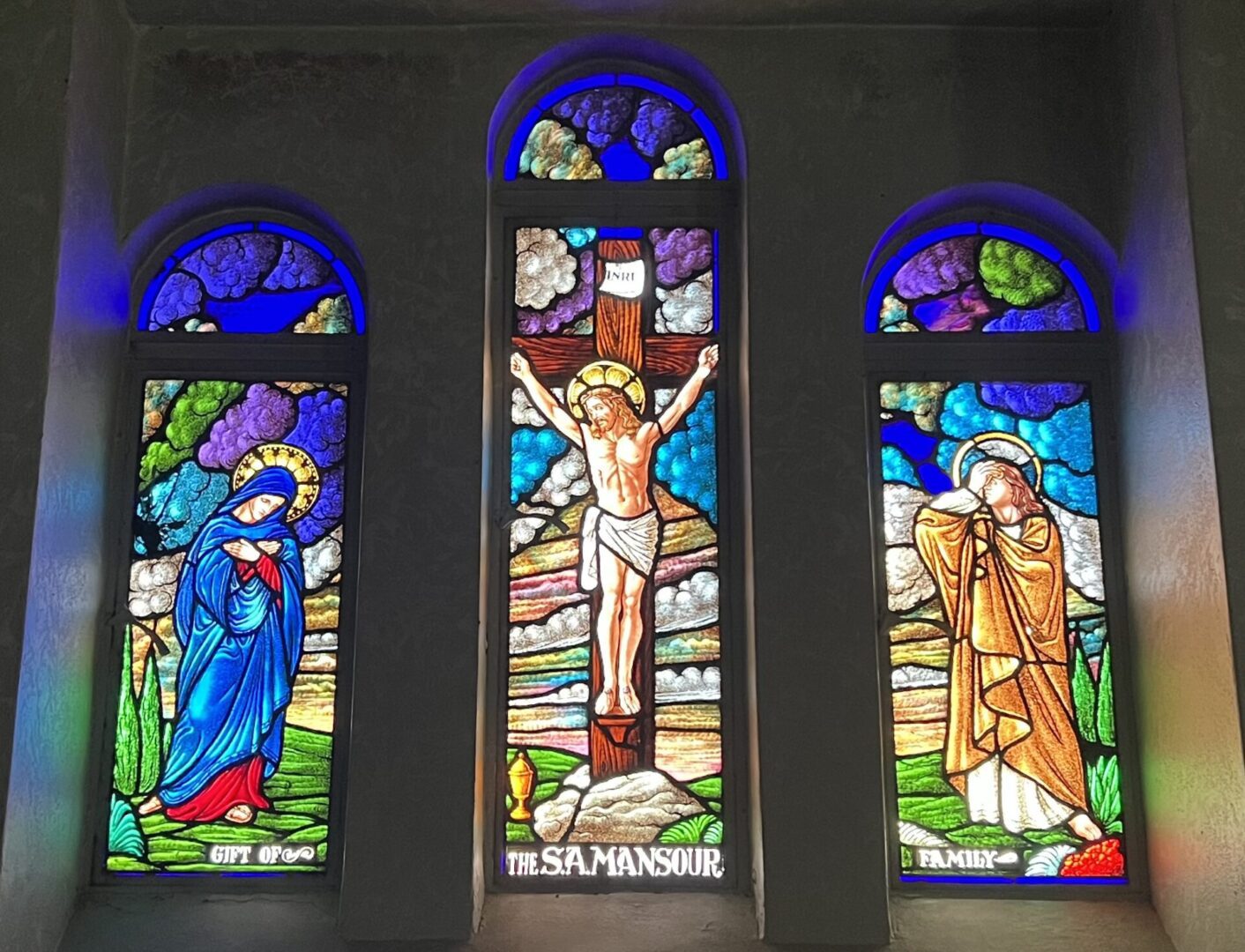
The Crucifixion and Death of Jesus
The trio of windows in the choir known as the Crucifixion of Christ with the two Mary’s in attendance was donated by the S.A. Mansour family. They had special sensitivity about the Crucifixion and death of Christ and devoutly attended and prayed the Stations of the Cross during Lent. Members of the family also prayed the Stations daily and had a great devotion to the Way of the Cross.
The Crucifixion was the culmination of the tortuous journey that Christ was made to undertake to atone for our sins and to merit us the gift of salvation. He willingly bore the cross to atone for our sins and after being beaten, mocked, flogged, crowned with thorns, and made to carry his own cross, he was crucified on a hillside named Golgotha. His Mother, Mary as well as Mary Magdalene and Mary of Copas were at the foot of the cross when he died and were there as they took his body down. They wrapped Him in linen and laid Him in the tomb of Joseph of Arimathea.
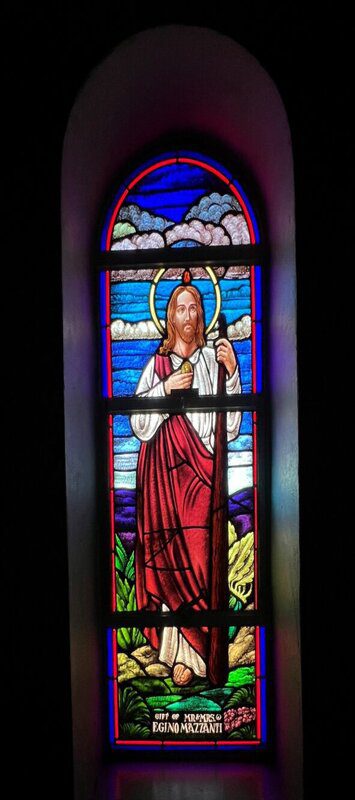
Saint Jude Thaddeus
The window in the stairwell on the north side of the choir is of Saint Jude Thaddeus, donated as a gift of the Egino Mazzanti family. He is the patron saint of desperate cases and of the impossible.
Mr. Egino had a burning devotion to the Sacred Heart of Jesus and really wanted to honor Him. It appears that in those days, so many revered and honored the Sacred Heart because of the promises made to St. Margaret Mary, and on the nine first Fridays, devotion was attended without fail. The belief is those who honor and revere the Sacred Heart will not die without the last sacraments and a chance of repentance. He also had a deep and strong devotion to Saint Isidore because Mr. Egino was a good farmer. However, since both of those windows had been donated, Father Hinckley persuaded Mr. Egino to give the window in honor of St. Jude.
Saint Jude was a relative of Jesus, the brother of James and the author of one epistle in the year 70, asking that all stand fast in the faith.
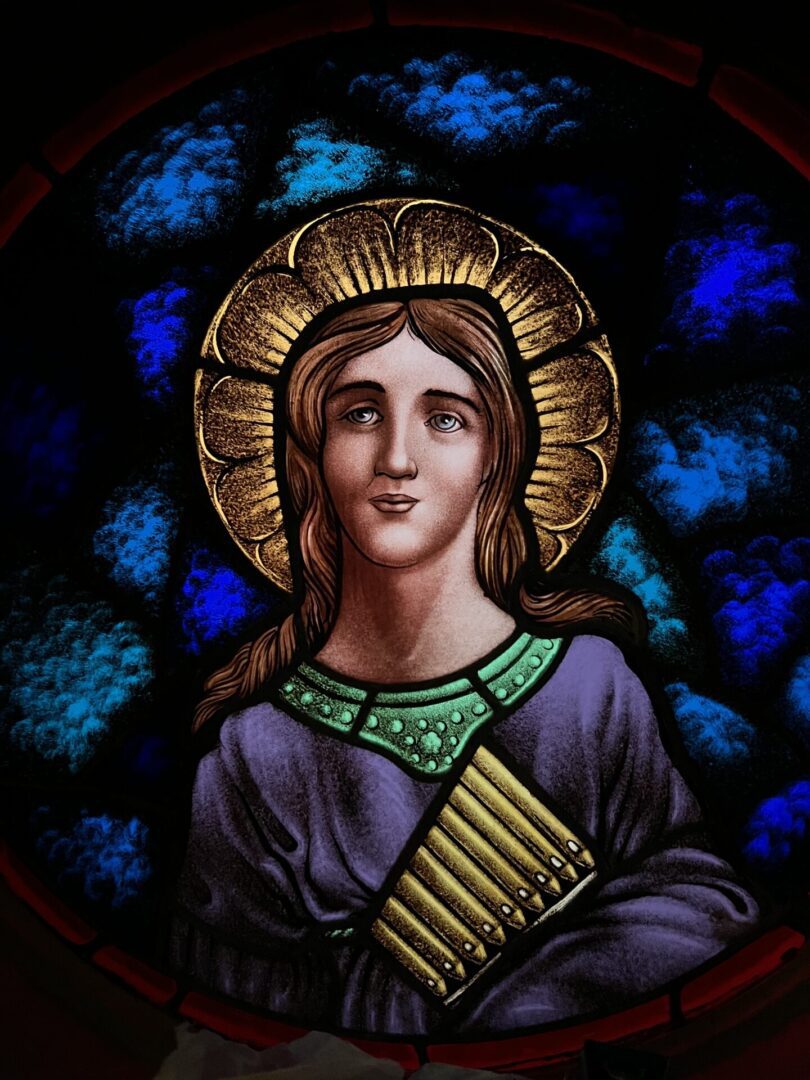
Saint Cecilia
The round window in the choir on the south side is of St. Cecilia. It is fitting that it be in the choir as she is the patroness of organ makers, musicians, and singers.
Devotion to St. Cecilia grew because of a dramatic and popular narrative of her tortures and death, which have some foundation. The story says, "Cecilia sang in her heart while the musical instruments sounded for her wedding."
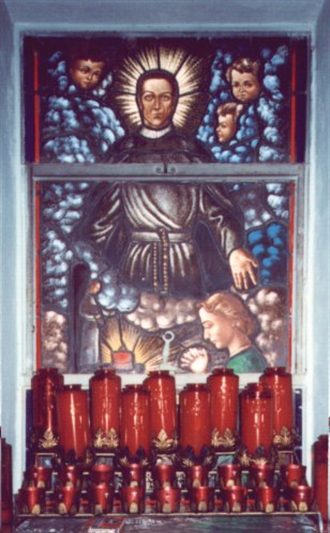
Saint Gerard Majella
The window in the cry room is of Saint Gerard Majella, who is the patron of childbirth, and was donated by the Fred Michael family at the birth of one of their children. Other donations to the church after other births included the tabernacle now used during Good Friday services, and the Crucifix that before 1981 was used in the sanctuary and afterward used for the processional during holy hour’s adoration of the Blessed Sacrament.
Saint Gerard was born at Muro, Italy, the son of a tailor, in 1726, and in his youth, became a servant in the household of the bishop of Lacedonga.
He served as a tailor after the bishop’s death and became known for his extraordinary supernatural gifts—bilocation, prophecy, ecstasies, visions, and infused knowledge.
Saint Gerard converted many sinners and was widely known for his holiness and charity. He was falsely accused of lechery, served as a porter, and ministered to the poor and raised funds for new buildings at Caposele where he died of consumption (tuberculosis) on October 15, 1755. He was canonized in 1904.